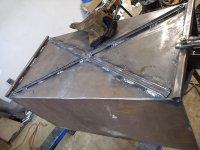thatbus
Well-known member
- Joined
- May 1, 2022
- Member Number
- 5129
- Messages
- 145
Check with the manufacturer on your servo valve, in many cases the port marked "tank" has a limit of something like 300 PSI and is not intended to be used for power beyond (which would be what you're doing in this case).
Edit, looking up there plumbing diagram for a Sprint car, they show the tank line off of their power steering rack going directly to the tank and the additional valve to control the wing being before the steering, based on that unless they say differently I would bet that there is a pressure limit on their tank port: https://sweetmanufacturing.com/uploads/files/Sprint Steering Plumbing Diagram.PDF

Additionally, you don't want your steering to be restricted if you're stomping on the brakes.
If there's only a pressure in and a return to tank out port your power assist/power steering will be reduced unless the out line is unobstructed.
If your hydro boost is downstream of the steering valve, when you are stomping on the brakes the fluid leaving the steering valve will not have any place to go until build enough pressure to overcome the resistance of the amount of force you're using from the power boost before you can steer.
Let's say you run a 1500 PSI pump, if your hydroboost is using enough flow to create 500 PSI of back pressure, that means you'll have 1000PSI worth of steering assist available, but to use it you'll have to overcome 500 PSI of back pressure.
Aaron Z
Thanks for the analysis here Aaron.
My Sweet servo is different; it's their "standard" size, but I think your analysis is correct. Sweet is extremely vague about all this stuff, though I sent them an email - hope they clarify.
This is what I have:
This is from Woodward steering which, far as I can tell, has an identical product:
The three highlighted points being key to why I think you're correct on this and my plumbing needs changed... That last point also explains why some Sweet diagrams have a -8 return and some have a -6 return with no explanation given. Annoying. What got me confused was Sweet often pairing this servovalve with their "pressurized" tank.
Worst case scenario I just put my hydraulic "loads" in "parallel" rather than in "series" correct? Like this?
Yellow "T's" being T fittings, and yellow circles being check valves (would those be necessary)?
If I do this, should I make the common feed and return lines a larger size (e.g. -8) before splitting off to each hydraulic load, or is it more important that only the return side is a larger size, so as to create a larger pressure differential?
WaterH Which unit is yours? My hydroboost unit (Bosch Hydromax from an IH 3800) definitely has a low pressure outlet; as it's just a barb with a hose clamp.
 ). That has a high pressure line from the power steering pump going to the hydroboost, then a high pressure line from the hydroboost to the steering box and a low pressure return to tank from the hydroboost and the steering box.
). That has a high pressure line from the power steering pump going to the hydroboost, then a high pressure line from the hydroboost to the steering box and a low pressure return to tank from the hydroboost and the steering box.

 Guy hung onto 8 of them for a few years, sold 4 a while ago, and canned the project they were intended for this year, so he sold the rest to me. They're stamped with August 2010 as the date of manufacture, DOT code, and a few different serial numbers. Found these on FB marketplace and couldn't believe my eyes lol.
Guy hung onto 8 of them for a few years, sold 4 a while ago, and canned the project they were intended for this year, so he sold the rest to me. They're stamped with August 2010 as the date of manufacture, DOT code, and a few different serial numbers. Found these on FB marketplace and couldn't believe my eyes lol.
 My current plan is to add something like Kelderman's 2-stage air ride. Simple enough to build. Would let me keep the leaves, have air ride, but if a bag blew, I would have the old shackle hanger still mounted on the frame as "backup" if that makes sense.
My current plan is to add something like Kelderman's 2-stage air ride. Simple enough to build. Would let me keep the leaves, have air ride, but if a bag blew, I would have the old shackle hanger still mounted on the frame as "backup" if that makes sense. .
.